Travel's Role in Shaping Tourists' Individual and Social Identities
VerifiedAdded on 2023/06/13
|13
|3619
|287
Essay
AI Summary
This essay examines the profound influence of travel experiences on shaping both the individual and social identities of tourists. It highlights how factors such as social distance, proximity, freedom, relationships with fellow travelers, self-presentation opportunities, and travel motivations contribute to this transformation. The essay delves into how tourists use travel to build personal and group identities, assimilate into new cultures, and undergo psychological changes through collective rites of passage. Furthermore, it discusses the role of narratives in shaping identity, particularly among backpackers seeking authentic experiences. The essay also explores how independent travel empowers women, fostering self-reflection, confidence, and leadership skills. Ultimately, the essay argues that travel provides a unique opportunity for self-discovery, identity change, and the construction of new meanings, impacting how tourists view themselves and their communities. Desklib offers a wealth of similar resources for students.
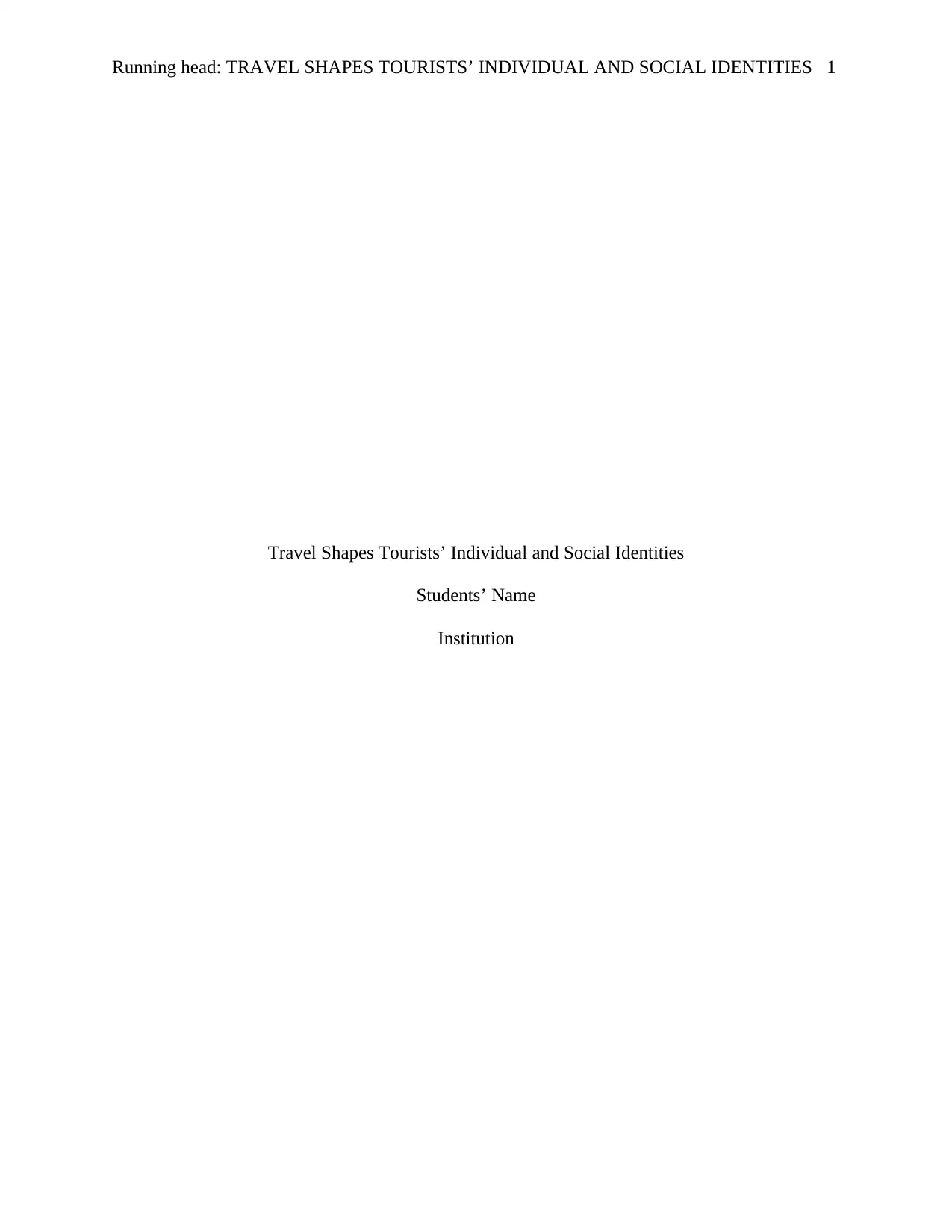
Running head: TRAVEL SHAPES TOURISTS’ INDIVIDUAL AND SOCIAL IDENTITIES 1
Travel Shapes Tourists’ Individual and Social Identities
Students’ Name
Institution
Travel Shapes Tourists’ Individual and Social Identities
Students’ Name
Institution
Paraphrase This Document
Need a fresh take? Get an instant paraphrase of this document with our AI Paraphraser
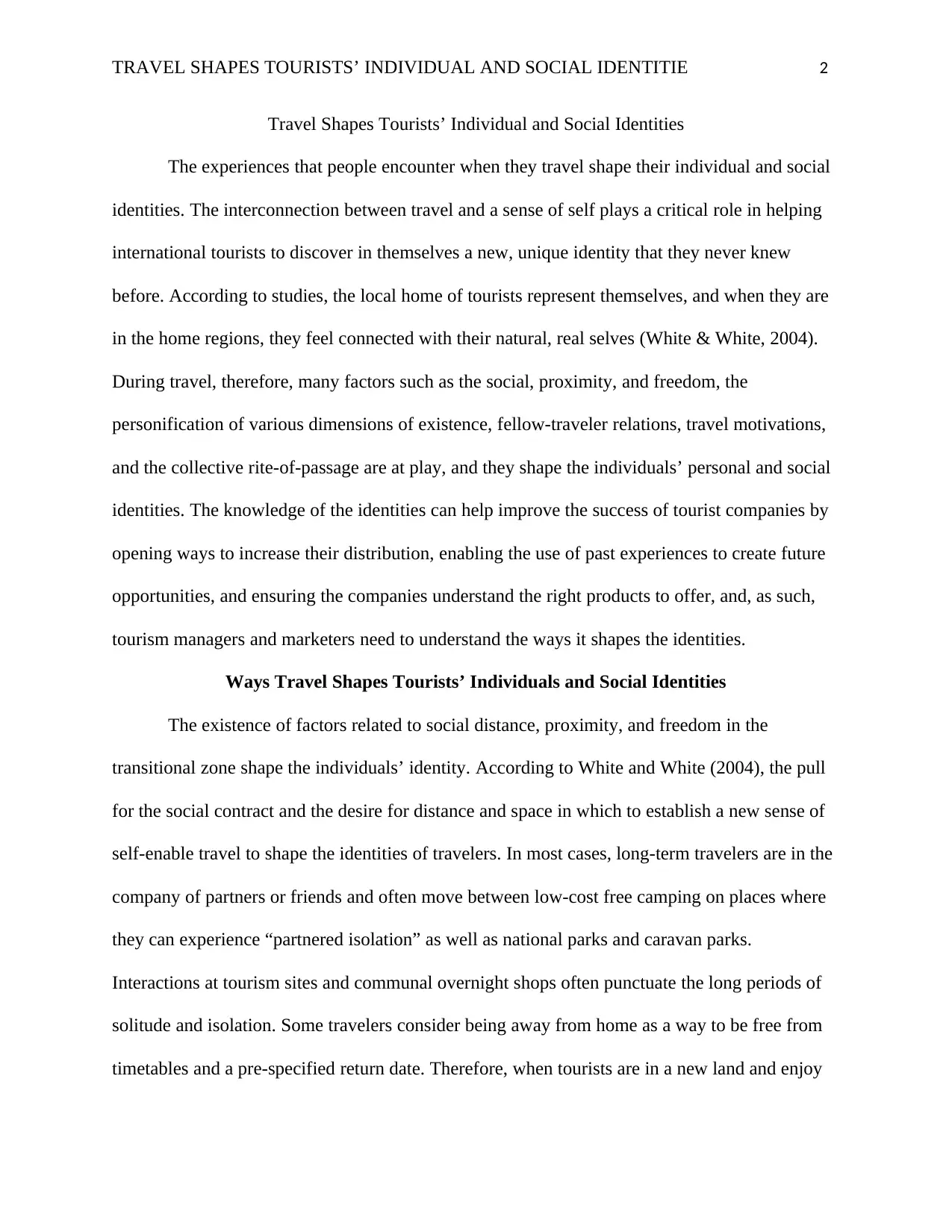
TRAVEL SHAPES TOURISTS’ INDIVIDUAL AND SOCIAL IDENTITIE 2
Travel Shapes Tourists’ Individual and Social Identities
The experiences that people encounter when they travel shape their individual and social
identities. The interconnection between travel and a sense of self plays a critical role in helping
international tourists to discover in themselves a new, unique identity that they never knew
before. According to studies, the local home of tourists represent themselves, and when they are
in the home regions, they feel connected with their natural, real selves (White & White, 2004).
During travel, therefore, many factors such as the social, proximity, and freedom, the
personification of various dimensions of existence, fellow-traveler relations, travel motivations,
and the collective rite-of-passage are at play, and they shape the individuals’ personal and social
identities. The knowledge of the identities can help improve the success of tourist companies by
opening ways to increase their distribution, enabling the use of past experiences to create future
opportunities, and ensuring the companies understand the right products to offer, and, as such,
tourism managers and marketers need to understand the ways it shapes the identities.
Ways Travel Shapes Tourists’ Individuals and Social Identities
The existence of factors related to social distance, proximity, and freedom in the
transitional zone shape the individuals’ identity. According to White and White (2004), the pull
for the social contract and the desire for distance and space in which to establish a new sense of
self-enable travel to shape the identities of travelers. In most cases, long-term travelers are in the
company of partners or friends and often move between low-cost free camping on places where
they can experience “partnered isolation” as well as national parks and caravan parks.
Interactions at tourism sites and communal overnight shops often punctuate the long periods of
solitude and isolation. Some travelers consider being away from home as a way to be free from
timetables and a pre-specified return date. Therefore, when tourists are in a new land and enjoy
Travel Shapes Tourists’ Individual and Social Identities
The experiences that people encounter when they travel shape their individual and social
identities. The interconnection between travel and a sense of self plays a critical role in helping
international tourists to discover in themselves a new, unique identity that they never knew
before. According to studies, the local home of tourists represent themselves, and when they are
in the home regions, they feel connected with their natural, real selves (White & White, 2004).
During travel, therefore, many factors such as the social, proximity, and freedom, the
personification of various dimensions of existence, fellow-traveler relations, travel motivations,
and the collective rite-of-passage are at play, and they shape the individuals’ personal and social
identities. The knowledge of the identities can help improve the success of tourist companies by
opening ways to increase their distribution, enabling the use of past experiences to create future
opportunities, and ensuring the companies understand the right products to offer, and, as such,
tourism managers and marketers need to understand the ways it shapes the identities.
Ways Travel Shapes Tourists’ Individuals and Social Identities
The existence of factors related to social distance, proximity, and freedom in the
transitional zone shape the individuals’ identity. According to White and White (2004), the pull
for the social contract and the desire for distance and space in which to establish a new sense of
self-enable travel to shape the identities of travelers. In most cases, long-term travelers are in the
company of partners or friends and often move between low-cost free camping on places where
they can experience “partnered isolation” as well as national parks and caravan parks.
Interactions at tourism sites and communal overnight shops often punctuate the long periods of
solitude and isolation. Some travelers consider being away from home as a way to be free from
timetables and a pre-specified return date. Therefore, when tourists are in a new land and enjoy
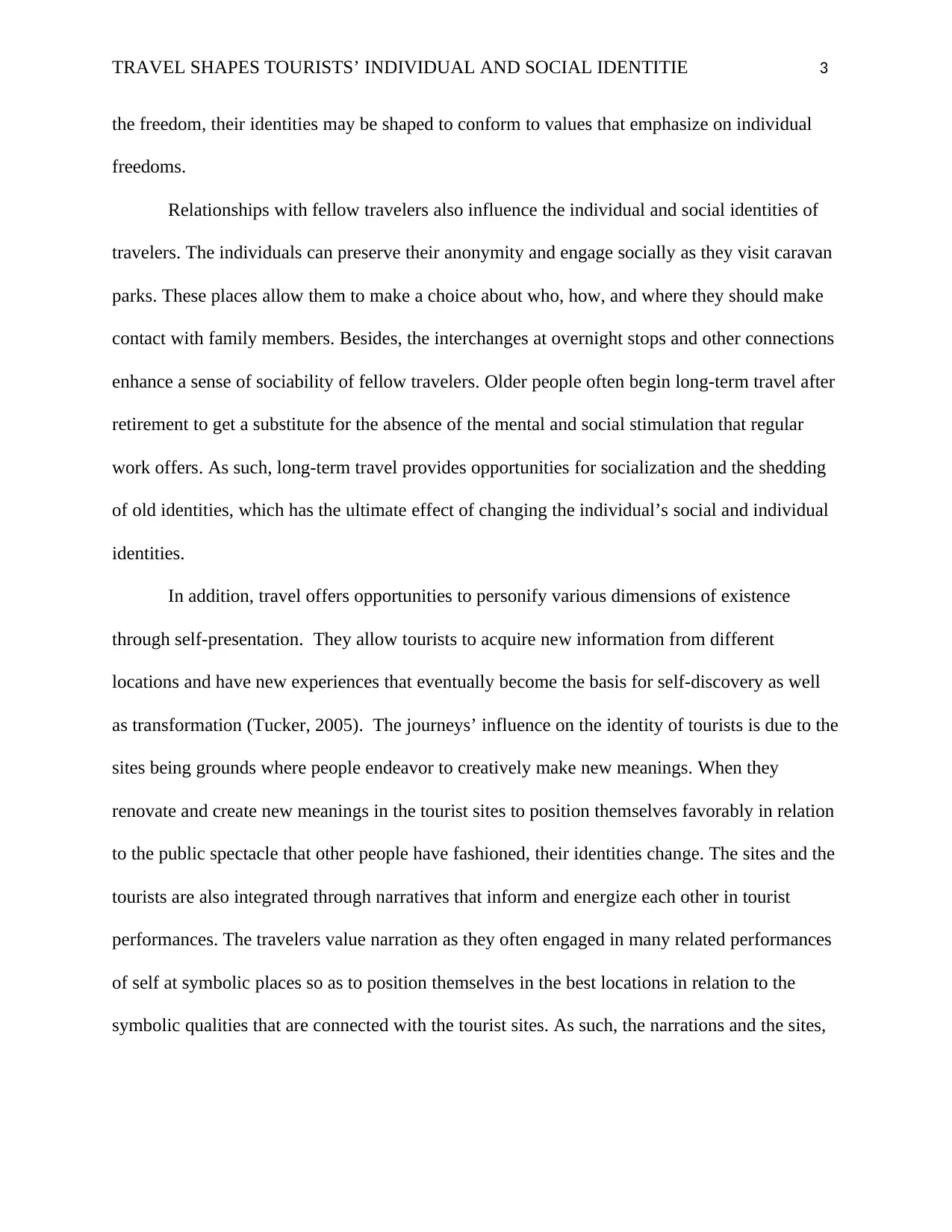
TRAVEL SHAPES TOURISTS’ INDIVIDUAL AND SOCIAL IDENTITIE 3
the freedom, their identities may be shaped to conform to values that emphasize on individual
freedoms.
Relationships with fellow travelers also influence the individual and social identities of
travelers. The individuals can preserve their anonymity and engage socially as they visit caravan
parks. These places allow them to make a choice about who, how, and where they should make
contact with family members. Besides, the interchanges at overnight stops and other connections
enhance a sense of sociability of fellow travelers. Older people often begin long-term travel after
retirement to get a substitute for the absence of the mental and social stimulation that regular
work offers. As such, long-term travel provides opportunities for socialization and the shedding
of old identities, which has the ultimate effect of changing the individual’s social and individual
identities.
In addition, travel offers opportunities to personify various dimensions of existence
through self-presentation. They allow tourists to acquire new information from different
locations and have new experiences that eventually become the basis for self-discovery as well
as transformation (Tucker, 2005). The journeys’ influence on the identity of tourists is due to the
sites being grounds where people endeavor to creatively make new meanings. When they
renovate and create new meanings in the tourist sites to position themselves favorably in relation
to the public spectacle that other people have fashioned, their identities change. The sites and the
tourists are also integrated through narratives that inform and energize each other in tourist
performances. The travelers value narration as they often engaged in many related performances
of self at symbolic places so as to position themselves in the best locations in relation to the
symbolic qualities that are connected with the tourist sites. As such, the narrations and the sites,
the freedom, their identities may be shaped to conform to values that emphasize on individual
freedoms.
Relationships with fellow travelers also influence the individual and social identities of
travelers. The individuals can preserve their anonymity and engage socially as they visit caravan
parks. These places allow them to make a choice about who, how, and where they should make
contact with family members. Besides, the interchanges at overnight stops and other connections
enhance a sense of sociability of fellow travelers. Older people often begin long-term travel after
retirement to get a substitute for the absence of the mental and social stimulation that regular
work offers. As such, long-term travel provides opportunities for socialization and the shedding
of old identities, which has the ultimate effect of changing the individual’s social and individual
identities.
In addition, travel offers opportunities to personify various dimensions of existence
through self-presentation. They allow tourists to acquire new information from different
locations and have new experiences that eventually become the basis for self-discovery as well
as transformation (Tucker, 2005). The journeys’ influence on the identity of tourists is due to the
sites being grounds where people endeavor to creatively make new meanings. When they
renovate and create new meanings in the tourist sites to position themselves favorably in relation
to the public spectacle that other people have fashioned, their identities change. The sites and the
tourists are also integrated through narratives that inform and energize each other in tourist
performances. The travelers value narration as they often engaged in many related performances
of self at symbolic places so as to position themselves in the best locations in relation to the
symbolic qualities that are connected with the tourist sites. As such, the narrations and the sites,
⊘ This is a preview!⊘
Do you want full access?
Subscribe today to unlock all pages.

Trusted by 1+ million students worldwide
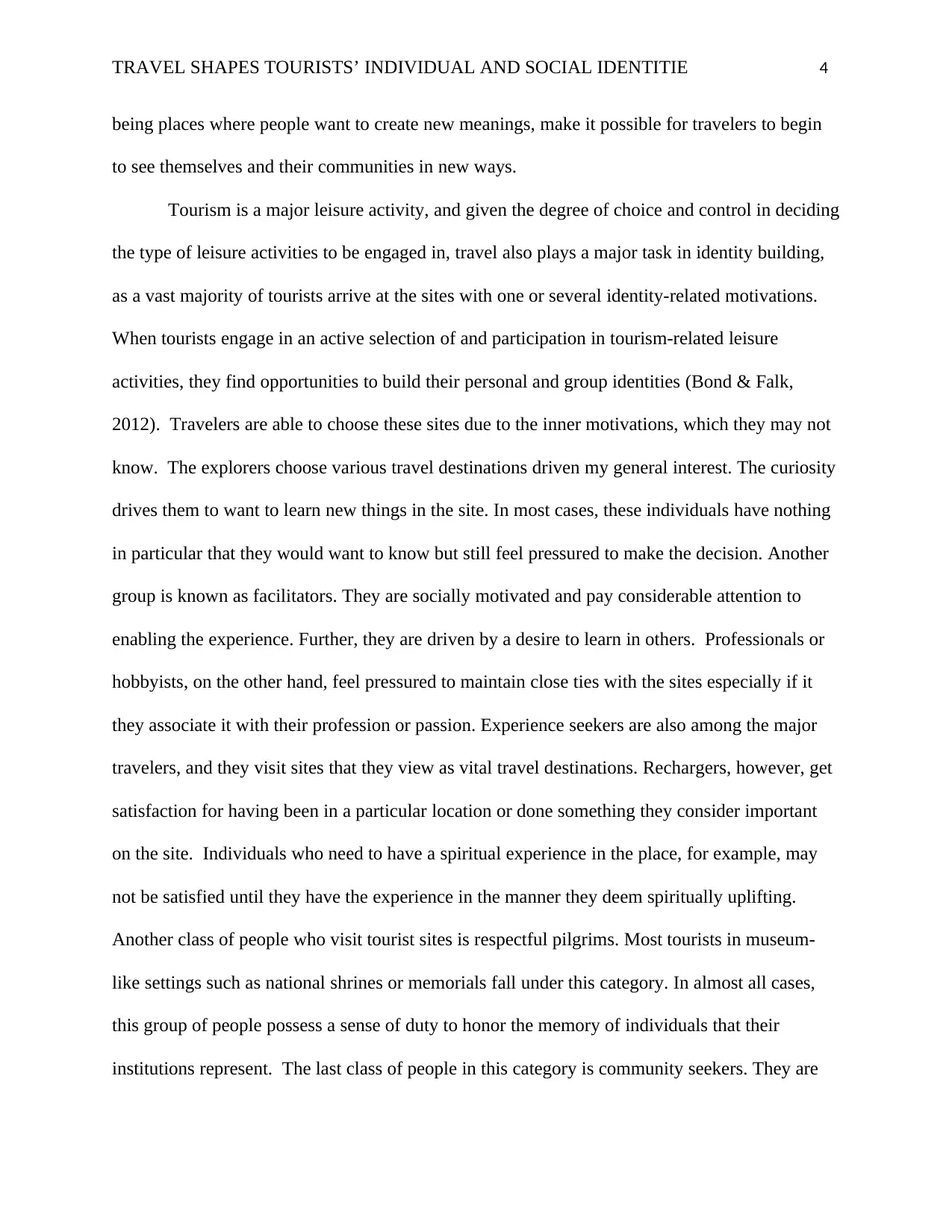
TRAVEL SHAPES TOURISTS’ INDIVIDUAL AND SOCIAL IDENTITIE 4
being places where people want to create new meanings, make it possible for travelers to begin
to see themselves and their communities in new ways.
Tourism is a major leisure activity, and given the degree of choice and control in deciding
the type of leisure activities to be engaged in, travel also plays a major task in identity building,
as a vast majority of tourists arrive at the sites with one or several identity-related motivations.
When tourists engage in an active selection of and participation in tourism-related leisure
activities, they find opportunities to build their personal and group identities (Bond & Falk,
2012). Travelers are able to choose these sites due to the inner motivations, which they may not
know. The explorers choose various travel destinations driven my general interest. The curiosity
drives them to want to learn new things in the site. In most cases, these individuals have nothing
in particular that they would want to know but still feel pressured to make the decision. Another
group is known as facilitators. They are socially motivated and pay considerable attention to
enabling the experience. Further, they are driven by a desire to learn in others. Professionals or
hobbyists, on the other hand, feel pressured to maintain close ties with the sites especially if it
they associate it with their profession or passion. Experience seekers are also among the major
travelers, and they visit sites that they view as vital travel destinations. Rechargers, however, get
satisfaction for having been in a particular location or done something they consider important
on the site. Individuals who need to have a spiritual experience in the place, for example, may
not be satisfied until they have the experience in the manner they deem spiritually uplifting.
Another class of people who visit tourist sites is respectful pilgrims. Most tourists in museum-
like settings such as national shrines or memorials fall under this category. In almost all cases,
this group of people possess a sense of duty to honor the memory of individuals that their
institutions represent. The last class of people in this category is community seekers. They are
being places where people want to create new meanings, make it possible for travelers to begin
to see themselves and their communities in new ways.
Tourism is a major leisure activity, and given the degree of choice and control in deciding
the type of leisure activities to be engaged in, travel also plays a major task in identity building,
as a vast majority of tourists arrive at the sites with one or several identity-related motivations.
When tourists engage in an active selection of and participation in tourism-related leisure
activities, they find opportunities to build their personal and group identities (Bond & Falk,
2012). Travelers are able to choose these sites due to the inner motivations, which they may not
know. The explorers choose various travel destinations driven my general interest. The curiosity
drives them to want to learn new things in the site. In most cases, these individuals have nothing
in particular that they would want to know but still feel pressured to make the decision. Another
group is known as facilitators. They are socially motivated and pay considerable attention to
enabling the experience. Further, they are driven by a desire to learn in others. Professionals or
hobbyists, on the other hand, feel pressured to maintain close ties with the sites especially if it
they associate it with their profession or passion. Experience seekers are also among the major
travelers, and they visit sites that they view as vital travel destinations. Rechargers, however, get
satisfaction for having been in a particular location or done something they consider important
on the site. Individuals who need to have a spiritual experience in the place, for example, may
not be satisfied until they have the experience in the manner they deem spiritually uplifting.
Another class of people who visit tourist sites is respectful pilgrims. Most tourists in museum-
like settings such as national shrines or memorials fall under this category. In almost all cases,
this group of people possess a sense of duty to honor the memory of individuals that their
institutions represent. The last class of people in this category is community seekers. They are
Paraphrase This Document
Need a fresh take? Get an instant paraphrase of this document with our AI Paraphraser
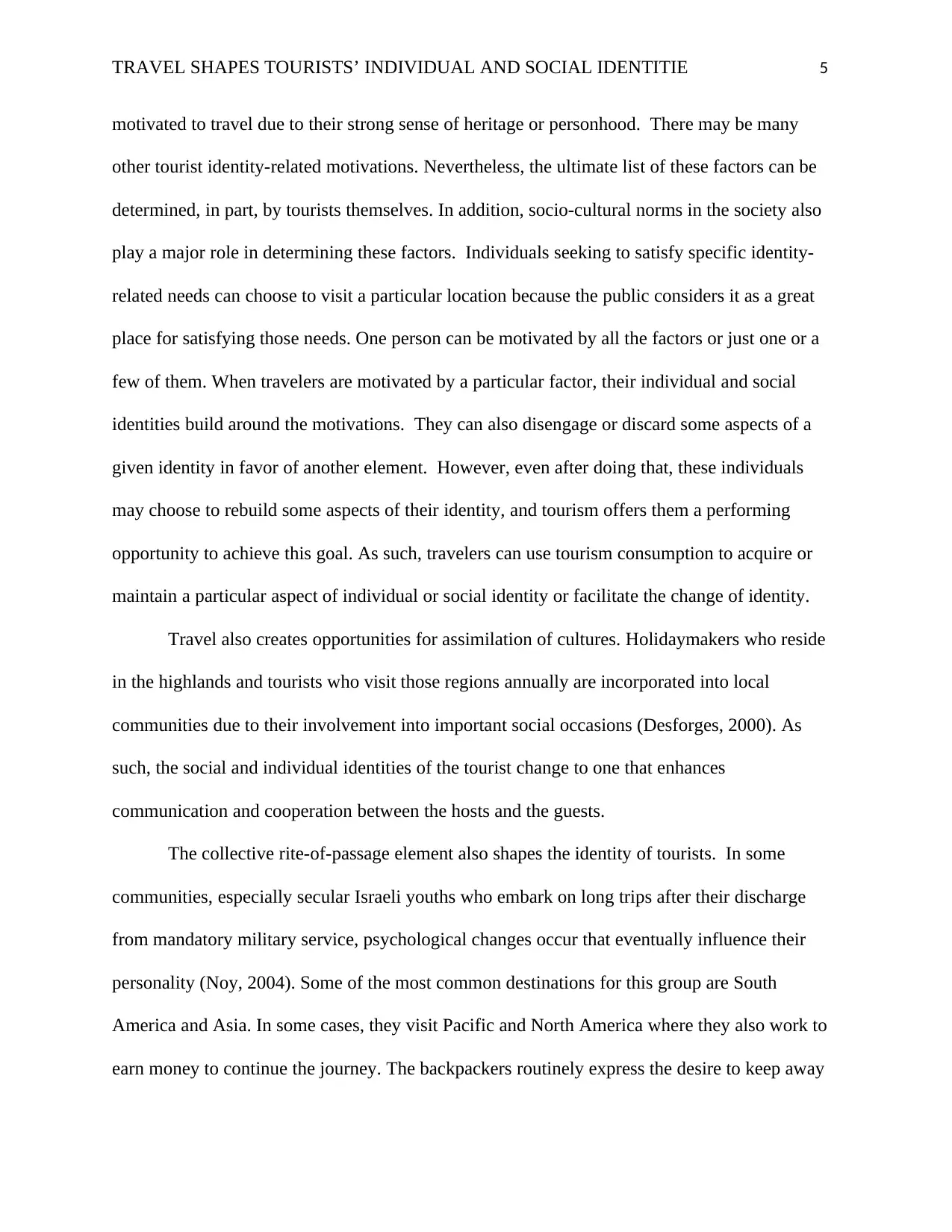
TRAVEL SHAPES TOURISTS’ INDIVIDUAL AND SOCIAL IDENTITIE 5
motivated to travel due to their strong sense of heritage or personhood. There may be many
other tourist identity-related motivations. Nevertheless, the ultimate list of these factors can be
determined, in part, by tourists themselves. In addition, socio-cultural norms in the society also
play a major role in determining these factors. Individuals seeking to satisfy specific identity-
related needs can choose to visit a particular location because the public considers it as a great
place for satisfying those needs. One person can be motivated by all the factors or just one or a
few of them. When travelers are motivated by a particular factor, their individual and social
identities build around the motivations. They can also disengage or discard some aspects of a
given identity in favor of another element. However, even after doing that, these individuals
may choose to rebuild some aspects of their identity, and tourism offers them a performing
opportunity to achieve this goal. As such, travelers can use tourism consumption to acquire or
maintain a particular aspect of individual or social identity or facilitate the change of identity.
Travel also creates opportunities for assimilation of cultures. Holidaymakers who reside
in the highlands and tourists who visit those regions annually are incorporated into local
communities due to their involvement into important social occasions (Desforges, 2000). As
such, the social and individual identities of the tourist change to one that enhances
communication and cooperation between the hosts and the guests.
The collective rite-of-passage element also shapes the identity of tourists. In some
communities, especially secular Israeli youths who embark on long trips after their discharge
from mandatory military service, psychological changes occur that eventually influence their
personality (Noy, 2004). Some of the most common destinations for this group are South
America and Asia. In some cases, they visit Pacific and North America where they also work to
earn money to continue the journey. The backpackers routinely express the desire to keep away
motivated to travel due to their strong sense of heritage or personhood. There may be many
other tourist identity-related motivations. Nevertheless, the ultimate list of these factors can be
determined, in part, by tourists themselves. In addition, socio-cultural norms in the society also
play a major role in determining these factors. Individuals seeking to satisfy specific identity-
related needs can choose to visit a particular location because the public considers it as a great
place for satisfying those needs. One person can be motivated by all the factors or just one or a
few of them. When travelers are motivated by a particular factor, their individual and social
identities build around the motivations. They can also disengage or discard some aspects of a
given identity in favor of another element. However, even after doing that, these individuals
may choose to rebuild some aspects of their identity, and tourism offers them a performing
opportunity to achieve this goal. As such, travelers can use tourism consumption to acquire or
maintain a particular aspect of individual or social identity or facilitate the change of identity.
Travel also creates opportunities for assimilation of cultures. Holidaymakers who reside
in the highlands and tourists who visit those regions annually are incorporated into local
communities due to their involvement into important social occasions (Desforges, 2000). As
such, the social and individual identities of the tourist change to one that enhances
communication and cooperation between the hosts and the guests.
The collective rite-of-passage element also shapes the identity of tourists. In some
communities, especially secular Israeli youths who embark on long trips after their discharge
from mandatory military service, psychological changes occur that eventually influence their
personality (Noy, 2004). Some of the most common destinations for this group are South
America and Asia. In some cases, they visit Pacific and North America where they also work to
earn money to continue the journey. The backpackers routinely express the desire to keep away
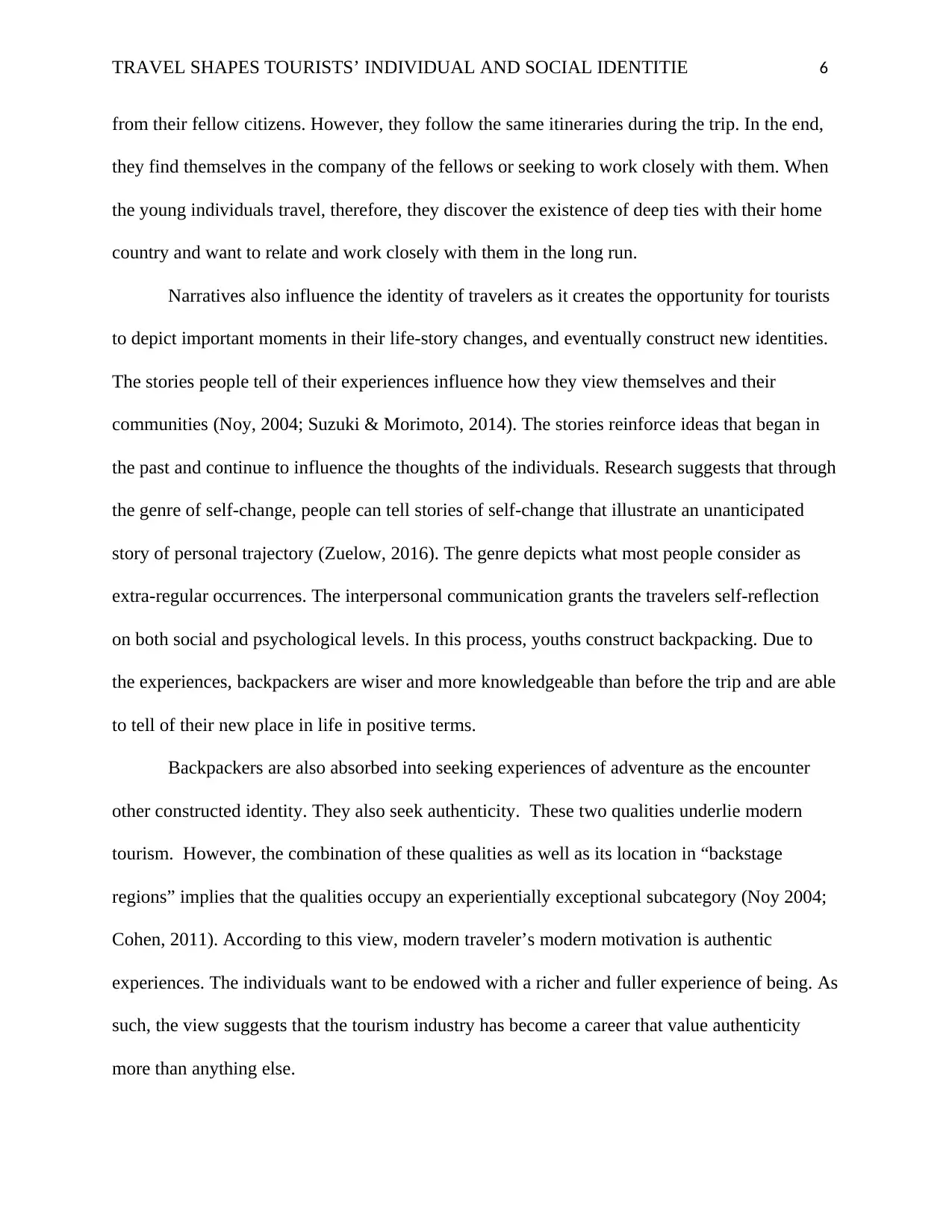
TRAVEL SHAPES TOURISTS’ INDIVIDUAL AND SOCIAL IDENTITIE 6
from their fellow citizens. However, they follow the same itineraries during the trip. In the end,
they find themselves in the company of the fellows or seeking to work closely with them. When
the young individuals travel, therefore, they discover the existence of deep ties with their home
country and want to relate and work closely with them in the long run.
Narratives also influence the identity of travelers as it creates the opportunity for tourists
to depict important moments in their life-story changes, and eventually construct new identities.
The stories people tell of their experiences influence how they view themselves and their
communities (Noy, 2004; Suzuki & Morimoto, 2014). The stories reinforce ideas that began in
the past and continue to influence the thoughts of the individuals. Research suggests that through
the genre of self-change, people can tell stories of self-change that illustrate an unanticipated
story of personal trajectory (Zuelow, 2016). The genre depicts what most people consider as
extra-regular occurrences. The interpersonal communication grants the travelers self-reflection
on both social and psychological levels. In this process, youths construct backpacking. Due to
the experiences, backpackers are wiser and more knowledgeable than before the trip and are able
to tell of their new place in life in positive terms.
Backpackers are also absorbed into seeking experiences of adventure as the encounter
other constructed identity. They also seek authenticity. These two qualities underlie modern
tourism. However, the combination of these qualities as well as its location in “backstage
regions” implies that the qualities occupy an experientially exceptional subcategory (Noy 2004;
Cohen, 2011). According to this view, modern traveler’s modern motivation is authentic
experiences. The individuals want to be endowed with a richer and fuller experience of being. As
such, the view suggests that the tourism industry has become a career that value authenticity
more than anything else.
from their fellow citizens. However, they follow the same itineraries during the trip. In the end,
they find themselves in the company of the fellows or seeking to work closely with them. When
the young individuals travel, therefore, they discover the existence of deep ties with their home
country and want to relate and work closely with them in the long run.
Narratives also influence the identity of travelers as it creates the opportunity for tourists
to depict important moments in their life-story changes, and eventually construct new identities.
The stories people tell of their experiences influence how they view themselves and their
communities (Noy, 2004; Suzuki & Morimoto, 2014). The stories reinforce ideas that began in
the past and continue to influence the thoughts of the individuals. Research suggests that through
the genre of self-change, people can tell stories of self-change that illustrate an unanticipated
story of personal trajectory (Zuelow, 2016). The genre depicts what most people consider as
extra-regular occurrences. The interpersonal communication grants the travelers self-reflection
on both social and psychological levels. In this process, youths construct backpacking. Due to
the experiences, backpackers are wiser and more knowledgeable than before the trip and are able
to tell of their new place in life in positive terms.
Backpackers are also absorbed into seeking experiences of adventure as the encounter
other constructed identity. They also seek authenticity. These two qualities underlie modern
tourism. However, the combination of these qualities as well as its location in “backstage
regions” implies that the qualities occupy an experientially exceptional subcategory (Noy 2004;
Cohen, 2011). According to this view, modern traveler’s modern motivation is authentic
experiences. The individuals want to be endowed with a richer and fuller experience of being. As
such, the view suggests that the tourism industry has become a career that value authenticity
more than anything else.
⊘ This is a preview!⊘
Do you want full access?
Subscribe today to unlock all pages.

Trusted by 1+ million students worldwide
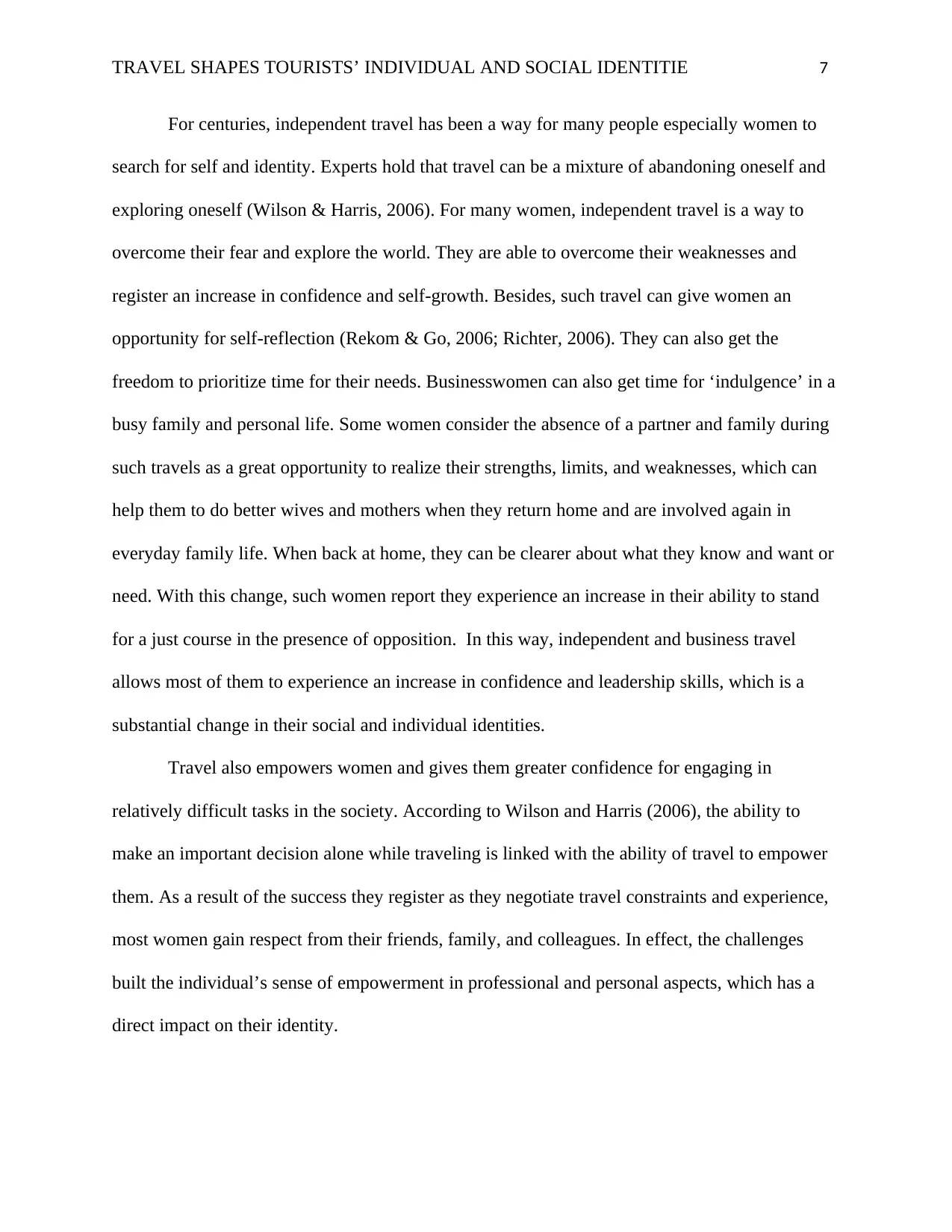
TRAVEL SHAPES TOURISTS’ INDIVIDUAL AND SOCIAL IDENTITIE 7
For centuries, independent travel has been a way for many people especially women to
search for self and identity. Experts hold that travel can be a mixture of abandoning oneself and
exploring oneself (Wilson & Harris, 2006). For many women, independent travel is a way to
overcome their fear and explore the world. They are able to overcome their weaknesses and
register an increase in confidence and self-growth. Besides, such travel can give women an
opportunity for self-reflection (Rekom & Go, 2006; Richter, 2006). They can also get the
freedom to prioritize time for their needs. Businesswomen can also get time for ‘indulgence’ in a
busy family and personal life. Some women consider the absence of a partner and family during
such travels as a great opportunity to realize their strengths, limits, and weaknesses, which can
help them to do better wives and mothers when they return home and are involved again in
everyday family life. When back at home, they can be clearer about what they know and want or
need. With this change, such women report they experience an increase in their ability to stand
for a just course in the presence of opposition. In this way, independent and business travel
allows most of them to experience an increase in confidence and leadership skills, which is a
substantial change in their social and individual identities.
Travel also empowers women and gives them greater confidence for engaging in
relatively difficult tasks in the society. According to Wilson and Harris (2006), the ability to
make an important decision alone while traveling is linked with the ability of travel to empower
them. As a result of the success they register as they negotiate travel constraints and experience,
most women gain respect from their friends, family, and colleagues. In effect, the challenges
built the individual’s sense of empowerment in professional and personal aspects, which has a
direct impact on their identity.
For centuries, independent travel has been a way for many people especially women to
search for self and identity. Experts hold that travel can be a mixture of abandoning oneself and
exploring oneself (Wilson & Harris, 2006). For many women, independent travel is a way to
overcome their fear and explore the world. They are able to overcome their weaknesses and
register an increase in confidence and self-growth. Besides, such travel can give women an
opportunity for self-reflection (Rekom & Go, 2006; Richter, 2006). They can also get the
freedom to prioritize time for their needs. Businesswomen can also get time for ‘indulgence’ in a
busy family and personal life. Some women consider the absence of a partner and family during
such travels as a great opportunity to realize their strengths, limits, and weaknesses, which can
help them to do better wives and mothers when they return home and are involved again in
everyday family life. When back at home, they can be clearer about what they know and want or
need. With this change, such women report they experience an increase in their ability to stand
for a just course in the presence of opposition. In this way, independent and business travel
allows most of them to experience an increase in confidence and leadership skills, which is a
substantial change in their social and individual identities.
Travel also empowers women and gives them greater confidence for engaging in
relatively difficult tasks in the society. According to Wilson and Harris (2006), the ability to
make an important decision alone while traveling is linked with the ability of travel to empower
them. As a result of the success they register as they negotiate travel constraints and experience,
most women gain respect from their friends, family, and colleagues. In effect, the challenges
built the individual’s sense of empowerment in professional and personal aspects, which has a
direct impact on their identity.
Paraphrase This Document
Need a fresh take? Get an instant paraphrase of this document with our AI Paraphraser
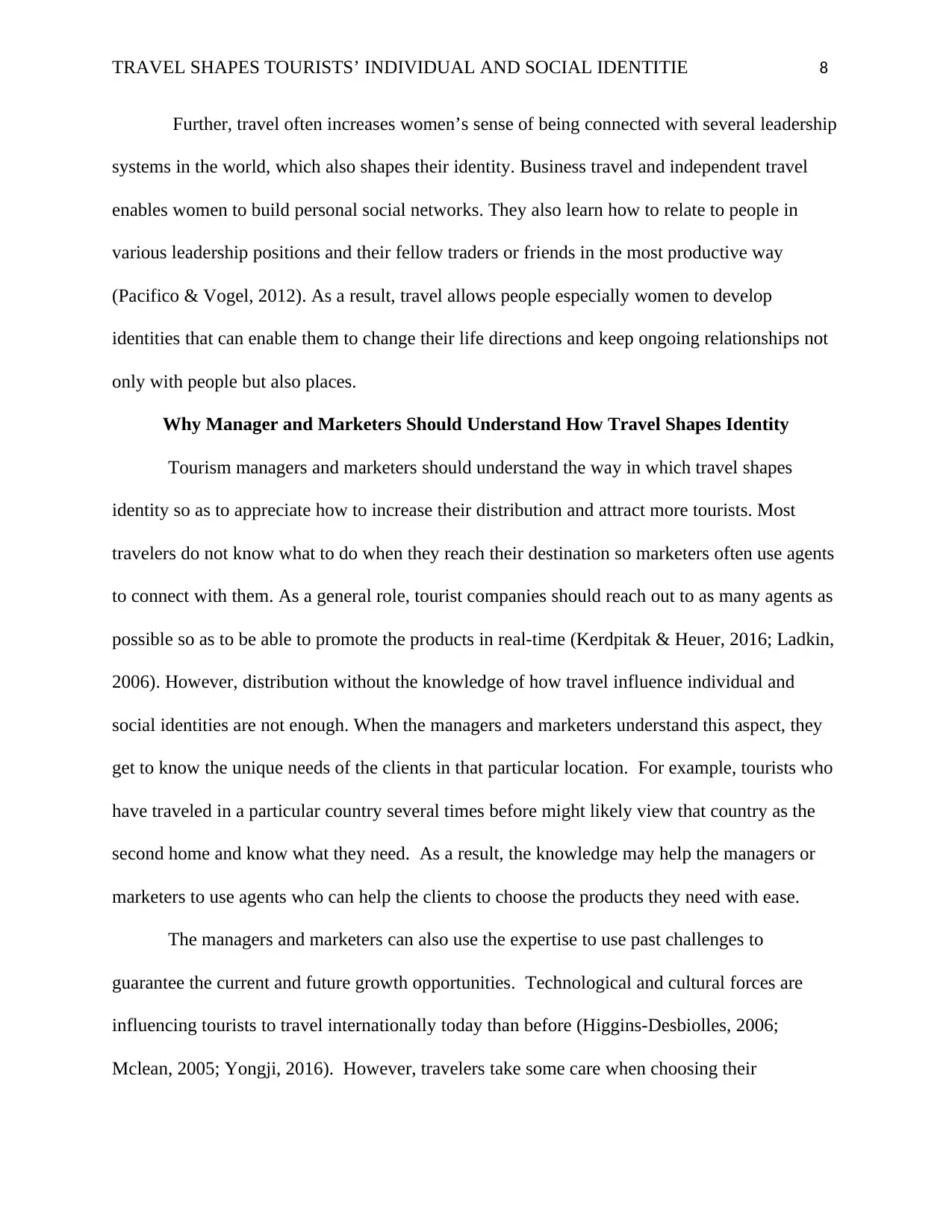
TRAVEL SHAPES TOURISTS’ INDIVIDUAL AND SOCIAL IDENTITIE 8
Further, travel often increases women’s sense of being connected with several leadership
systems in the world, which also shapes their identity. Business travel and independent travel
enables women to build personal social networks. They also learn how to relate to people in
various leadership positions and their fellow traders or friends in the most productive way
(Pacifico & Vogel, 2012). As a result, travel allows people especially women to develop
identities that can enable them to change their life directions and keep ongoing relationships not
only with people but also places.
Why Manager and Marketers Should Understand How Travel Shapes Identity
Tourism managers and marketers should understand the way in which travel shapes
identity so as to appreciate how to increase their distribution and attract more tourists. Most
travelers do not know what to do when they reach their destination so marketers often use agents
to connect with them. As a general role, tourist companies should reach out to as many agents as
possible so as to be able to promote the products in real-time (Kerdpitak & Heuer, 2016; Ladkin,
2006). However, distribution without the knowledge of how travel influence individual and
social identities are not enough. When the managers and marketers understand this aspect, they
get to know the unique needs of the clients in that particular location. For example, tourists who
have traveled in a particular country several times before might likely view that country as the
second home and know what they need. As a result, the knowledge may help the managers or
marketers to use agents who can help the clients to choose the products they need with ease.
The managers and marketers can also use the expertise to use past challenges to
guarantee the current and future growth opportunities. Technological and cultural forces are
influencing tourists to travel internationally today than before (Higgins-Desbiolles, 2006;
Mclean, 2005; Yongji, 2016). However, travelers take some care when choosing their
Further, travel often increases women’s sense of being connected with several leadership
systems in the world, which also shapes their identity. Business travel and independent travel
enables women to build personal social networks. They also learn how to relate to people in
various leadership positions and their fellow traders or friends in the most productive way
(Pacifico & Vogel, 2012). As a result, travel allows people especially women to develop
identities that can enable them to change their life directions and keep ongoing relationships not
only with people but also places.
Why Manager and Marketers Should Understand How Travel Shapes Identity
Tourism managers and marketers should understand the way in which travel shapes
identity so as to appreciate how to increase their distribution and attract more tourists. Most
travelers do not know what to do when they reach their destination so marketers often use agents
to connect with them. As a general role, tourist companies should reach out to as many agents as
possible so as to be able to promote the products in real-time (Kerdpitak & Heuer, 2016; Ladkin,
2006). However, distribution without the knowledge of how travel influence individual and
social identities are not enough. When the managers and marketers understand this aspect, they
get to know the unique needs of the clients in that particular location. For example, tourists who
have traveled in a particular country several times before might likely view that country as the
second home and know what they need. As a result, the knowledge may help the managers or
marketers to use agents who can help the clients to choose the products they need with ease.
The managers and marketers can also use the expertise to use past challenges to
guarantee the current and future growth opportunities. Technological and cultural forces are
influencing tourists to travel internationally today than before (Higgins-Desbiolles, 2006;
Mclean, 2005; Yongji, 2016). However, travelers take some care when choosing their
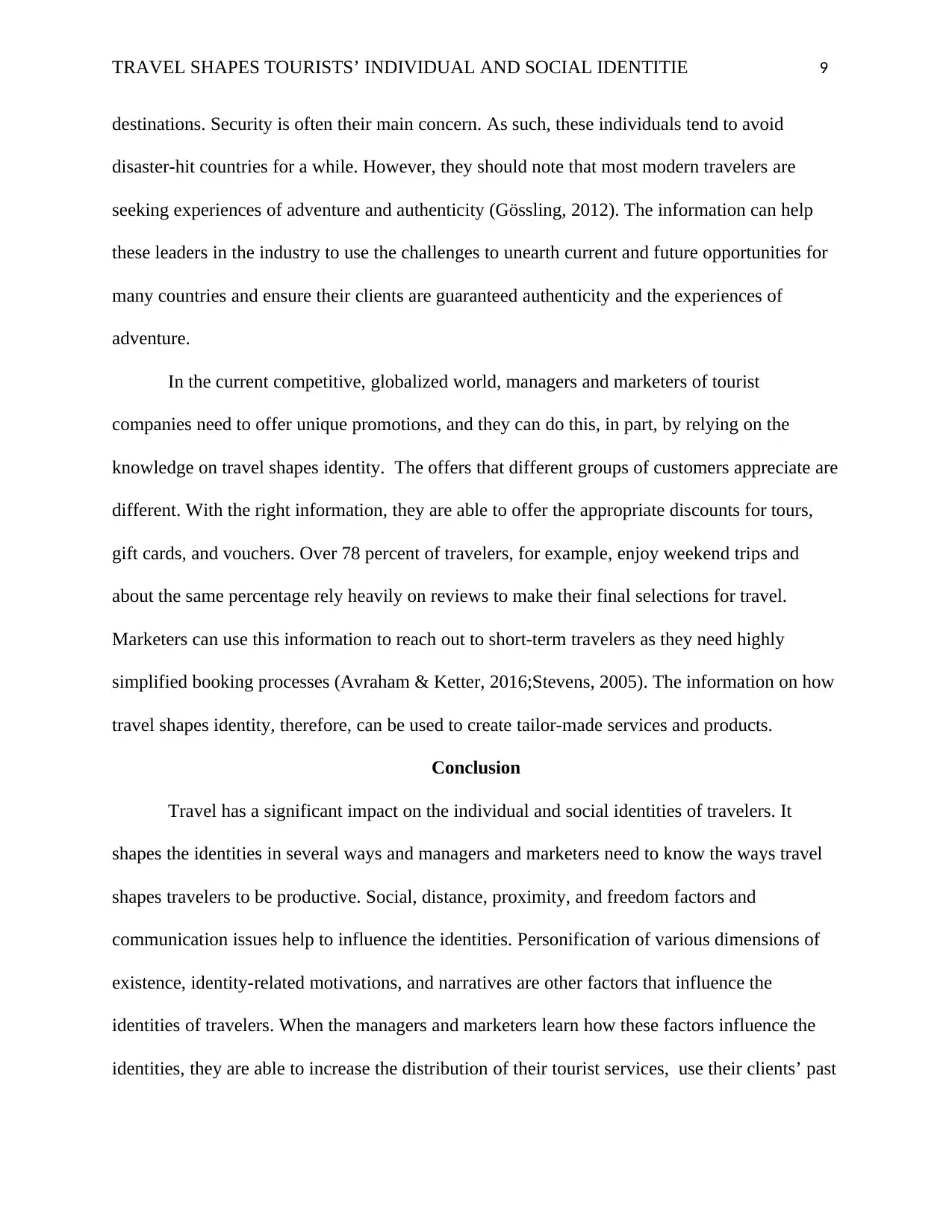
TRAVEL SHAPES TOURISTS’ INDIVIDUAL AND SOCIAL IDENTITIE 9
destinations. Security is often their main concern. As such, these individuals tend to avoid
disaster-hit countries for a while. However, they should note that most modern travelers are
seeking experiences of adventure and authenticity (Gössling, 2012). The information can help
these leaders in the industry to use the challenges to unearth current and future opportunities for
many countries and ensure their clients are guaranteed authenticity and the experiences of
adventure.
In the current competitive, globalized world, managers and marketers of tourist
companies need to offer unique promotions, and they can do this, in part, by relying on the
knowledge on travel shapes identity. The offers that different groups of customers appreciate are
different. With the right information, they are able to offer the appropriate discounts for tours,
gift cards, and vouchers. Over 78 percent of travelers, for example, enjoy weekend trips and
about the same percentage rely heavily on reviews to make their final selections for travel.
Marketers can use this information to reach out to short-term travelers as they need highly
simplified booking processes (Avraham & Ketter, 2016;Stevens, 2005). The information on how
travel shapes identity, therefore, can be used to create tailor-made services and products.
Conclusion
Travel has a significant impact on the individual and social identities of travelers. It
shapes the identities in several ways and managers and marketers need to know the ways travel
shapes travelers to be productive. Social, distance, proximity, and freedom factors and
communication issues help to influence the identities. Personification of various dimensions of
existence, identity-related motivations, and narratives are other factors that influence the
identities of travelers. When the managers and marketers learn how these factors influence the
identities, they are able to increase the distribution of their tourist services, use their clients’ past
destinations. Security is often their main concern. As such, these individuals tend to avoid
disaster-hit countries for a while. However, they should note that most modern travelers are
seeking experiences of adventure and authenticity (Gössling, 2012). The information can help
these leaders in the industry to use the challenges to unearth current and future opportunities for
many countries and ensure their clients are guaranteed authenticity and the experiences of
adventure.
In the current competitive, globalized world, managers and marketers of tourist
companies need to offer unique promotions, and they can do this, in part, by relying on the
knowledge on travel shapes identity. The offers that different groups of customers appreciate are
different. With the right information, they are able to offer the appropriate discounts for tours,
gift cards, and vouchers. Over 78 percent of travelers, for example, enjoy weekend trips and
about the same percentage rely heavily on reviews to make their final selections for travel.
Marketers can use this information to reach out to short-term travelers as they need highly
simplified booking processes (Avraham & Ketter, 2016;Stevens, 2005). The information on how
travel shapes identity, therefore, can be used to create tailor-made services and products.
Conclusion
Travel has a significant impact on the individual and social identities of travelers. It
shapes the identities in several ways and managers and marketers need to know the ways travel
shapes travelers to be productive. Social, distance, proximity, and freedom factors and
communication issues help to influence the identities. Personification of various dimensions of
existence, identity-related motivations, and narratives are other factors that influence the
identities of travelers. When the managers and marketers learn how these factors influence the
identities, they are able to increase the distribution of their tourist services, use their clients’ past
⊘ This is a preview!⊘
Do you want full access?
Subscribe today to unlock all pages.

Trusted by 1+ million students worldwide
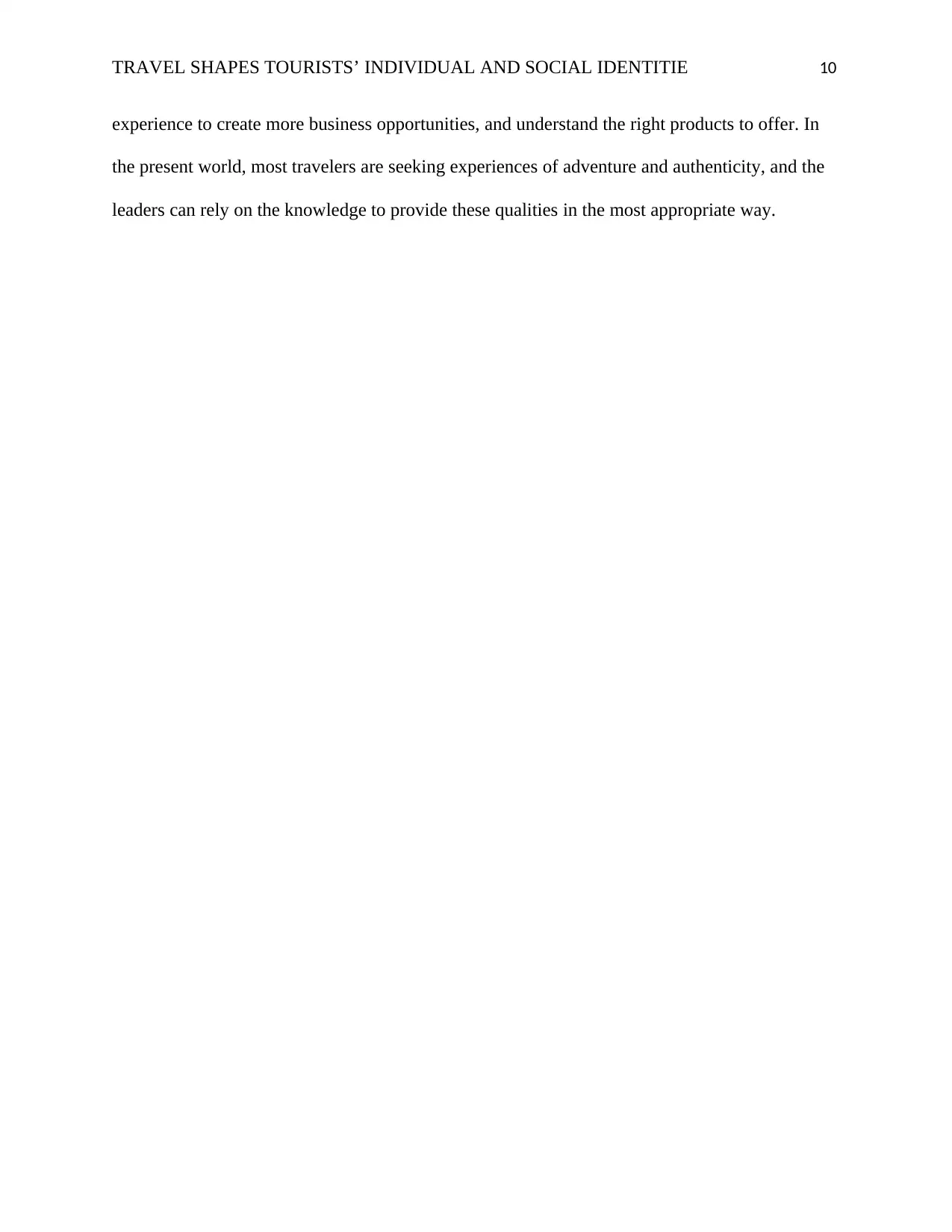
TRAVEL SHAPES TOURISTS’ INDIVIDUAL AND SOCIAL IDENTITIE 10
experience to create more business opportunities, and understand the right products to offer. In
the present world, most travelers are seeking experiences of adventure and authenticity, and the
leaders can rely on the knowledge to provide these qualities in the most appropriate way.
experience to create more business opportunities, and understand the right products to offer. In
the present world, most travelers are seeking experiences of adventure and authenticity, and the
leaders can rely on the knowledge to provide these qualities in the most appropriate way.
Paraphrase This Document
Need a fresh take? Get an instant paraphrase of this document with our AI Paraphraser
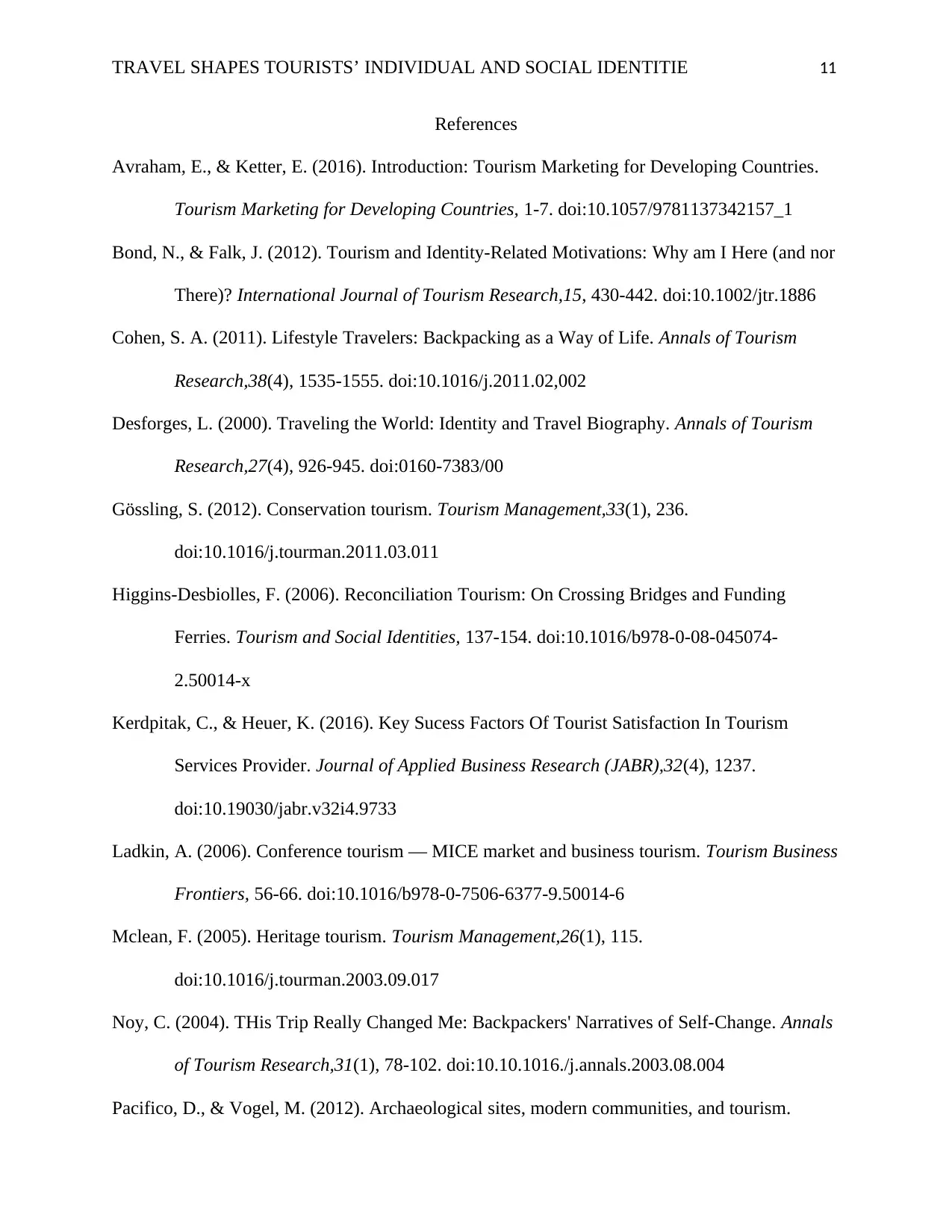
TRAVEL SHAPES TOURISTS’ INDIVIDUAL AND SOCIAL IDENTITIE 11
References
Avraham, E., & Ketter, E. (2016). Introduction: Tourism Marketing for Developing Countries.
Tourism Marketing for Developing Countries, 1-7. doi:10.1057/9781137342157_1
Bond, N., & Falk, J. (2012). Tourism and Identity-Related Motivations: Why am I Here (and nor
There)? International Journal of Tourism Research,15, 430-442. doi:10.1002/jtr.1886
Cohen, S. A. (2011). Lifestyle Travelers: Backpacking as a Way of Life. Annals of Tourism
Research,38(4), 1535-1555. doi:10.1016/j.2011.02,002
Desforges, L. (2000). Traveling the World: Identity and Travel Biography. Annals of Tourism
Research,27(4), 926-945. doi:0160-7383/00
Gössling, S. (2012). Conservation tourism. Tourism Management,33(1), 236.
doi:10.1016/j.tourman.2011.03.011
Higgins-Desbiolles, F. (2006). Reconciliation Tourism: On Crossing Bridges and Funding
Ferries. Tourism and Social Identities, 137-154. doi:10.1016/b978-0-08-045074-
2.50014-x
Kerdpitak, C., & Heuer, K. (2016). Key Sucess Factors Of Tourist Satisfaction In Tourism
Services Provider. Journal of Applied Business Research (JABR),32(4), 1237.
doi:10.19030/jabr.v32i4.9733
Ladkin, A. (2006). Conference tourism — MICE market and business tourism. Tourism Business
Frontiers, 56-66. doi:10.1016/b978-0-7506-6377-9.50014-6
Mclean, F. (2005). Heritage tourism. Tourism Management,26(1), 115.
doi:10.1016/j.tourman.2003.09.017
Noy, C. (2004). THis Trip Really Changed Me: Backpackers' Narratives of Self-Change. Annals
of Tourism Research,31(1), 78-102. doi:10.10.1016./j.annals.2003.08.004
Pacifico, D., & Vogel, M. (2012). Archaeological sites, modern communities, and tourism.
References
Avraham, E., & Ketter, E. (2016). Introduction: Tourism Marketing for Developing Countries.
Tourism Marketing for Developing Countries, 1-7. doi:10.1057/9781137342157_1
Bond, N., & Falk, J. (2012). Tourism and Identity-Related Motivations: Why am I Here (and nor
There)? International Journal of Tourism Research,15, 430-442. doi:10.1002/jtr.1886
Cohen, S. A. (2011). Lifestyle Travelers: Backpacking as a Way of Life. Annals of Tourism
Research,38(4), 1535-1555. doi:10.1016/j.2011.02,002
Desforges, L. (2000). Traveling the World: Identity and Travel Biography. Annals of Tourism
Research,27(4), 926-945. doi:0160-7383/00
Gössling, S. (2012). Conservation tourism. Tourism Management,33(1), 236.
doi:10.1016/j.tourman.2011.03.011
Higgins-Desbiolles, F. (2006). Reconciliation Tourism: On Crossing Bridges and Funding
Ferries. Tourism and Social Identities, 137-154. doi:10.1016/b978-0-08-045074-
2.50014-x
Kerdpitak, C., & Heuer, K. (2016). Key Sucess Factors Of Tourist Satisfaction In Tourism
Services Provider. Journal of Applied Business Research (JABR),32(4), 1237.
doi:10.19030/jabr.v32i4.9733
Ladkin, A. (2006). Conference tourism — MICE market and business tourism. Tourism Business
Frontiers, 56-66. doi:10.1016/b978-0-7506-6377-9.50014-6
Mclean, F. (2005). Heritage tourism. Tourism Management,26(1), 115.
doi:10.1016/j.tourman.2003.09.017
Noy, C. (2004). THis Trip Really Changed Me: Backpackers' Narratives of Self-Change. Annals
of Tourism Research,31(1), 78-102. doi:10.10.1016./j.annals.2003.08.004
Pacifico, D., & Vogel, M. (2012). Archaeological sites, modern communities, and tourism.
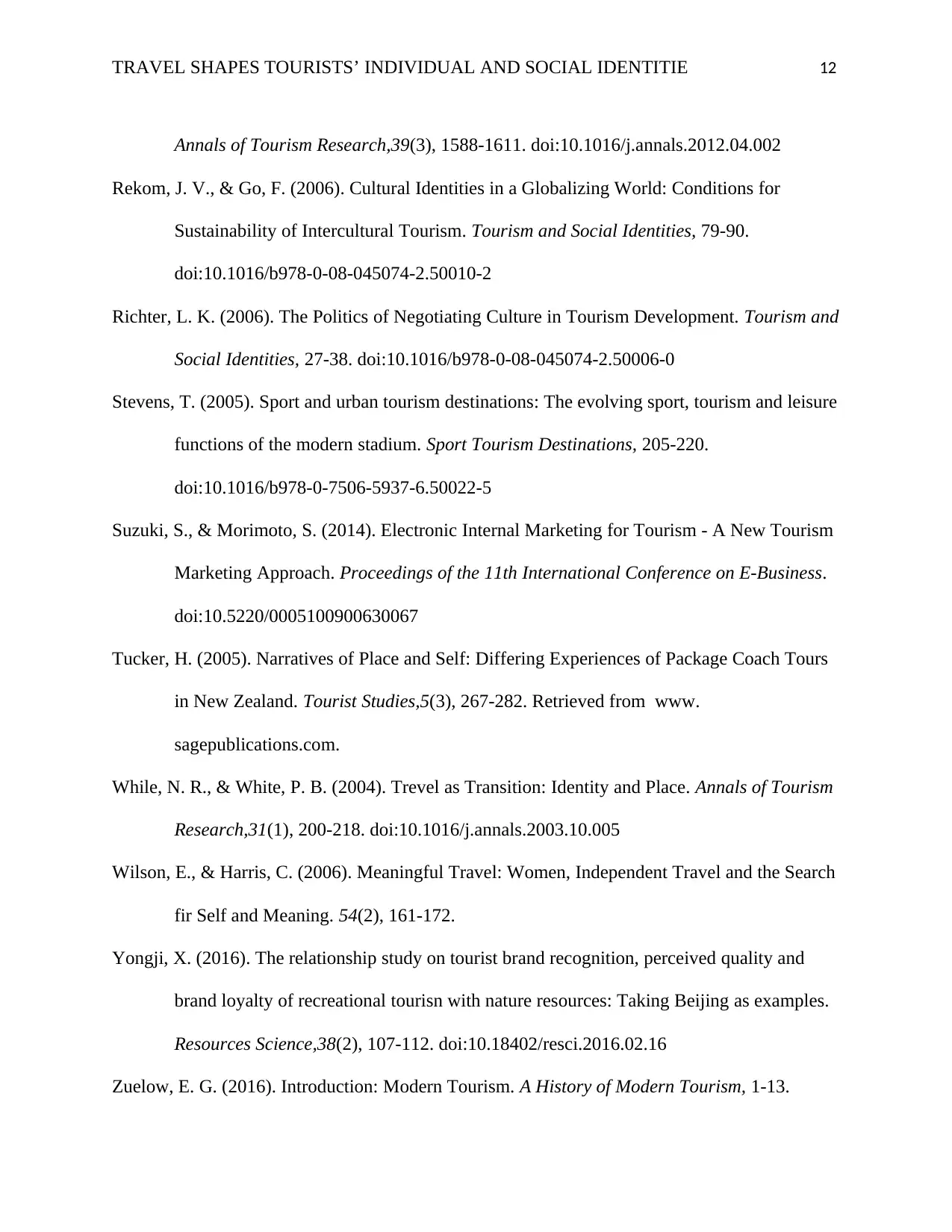
TRAVEL SHAPES TOURISTS’ INDIVIDUAL AND SOCIAL IDENTITIE 12
Annals of Tourism Research,39(3), 1588-1611. doi:10.1016/j.annals.2012.04.002
Rekom, J. V., & Go, F. (2006). Cultural Identities in a Globalizing World: Conditions for
Sustainability of Intercultural Tourism. Tourism and Social Identities, 79-90.
doi:10.1016/b978-0-08-045074-2.50010-2
Richter, L. K. (2006). The Politics of Negotiating Culture in Tourism Development. Tourism and
Social Identities, 27-38. doi:10.1016/b978-0-08-045074-2.50006-0
Stevens, T. (2005). Sport and urban tourism destinations: The evolving sport, tourism and leisure
functions of the modern stadium. Sport Tourism Destinations, 205-220.
doi:10.1016/b978-0-7506-5937-6.50022-5
Suzuki, S., & Morimoto, S. (2014). Electronic Internal Marketing for Tourism - A New Tourism
Marketing Approach. Proceedings of the 11th International Conference on E-Business.
doi:10.5220/0005100900630067
Tucker, H. (2005). Narratives of Place and Self: Differing Experiences of Package Coach Tours
in New Zealand. Tourist Studies,5(3), 267-282. Retrieved from www.
sagepublications.com.
While, N. R., & White, P. B. (2004). Trevel as Transition: Identity and Place. Annals of Tourism
Research,31(1), 200-218. doi:10.1016/j.annals.2003.10.005
Wilson, E., & Harris, C. (2006). Meaningful Travel: Women, Independent Travel and the Search
fir Self and Meaning. 54(2), 161-172.
Yongji, X. (2016). The relationship study on tourist brand recognition, perceived quality and
brand loyalty of recreational tourisn with nature resources: Taking Beijing as examples.
Resources Science,38(2), 107-112. doi:10.18402/resci.2016.02.16
Zuelow, E. G. (2016). Introduction: Modern Tourism. A History of Modern Tourism, 1-13.
Annals of Tourism Research,39(3), 1588-1611. doi:10.1016/j.annals.2012.04.002
Rekom, J. V., & Go, F. (2006). Cultural Identities in a Globalizing World: Conditions for
Sustainability of Intercultural Tourism. Tourism and Social Identities, 79-90.
doi:10.1016/b978-0-08-045074-2.50010-2
Richter, L. K. (2006). The Politics of Negotiating Culture in Tourism Development. Tourism and
Social Identities, 27-38. doi:10.1016/b978-0-08-045074-2.50006-0
Stevens, T. (2005). Sport and urban tourism destinations: The evolving sport, tourism and leisure
functions of the modern stadium. Sport Tourism Destinations, 205-220.
doi:10.1016/b978-0-7506-5937-6.50022-5
Suzuki, S., & Morimoto, S. (2014). Electronic Internal Marketing for Tourism - A New Tourism
Marketing Approach. Proceedings of the 11th International Conference on E-Business.
doi:10.5220/0005100900630067
Tucker, H. (2005). Narratives of Place and Self: Differing Experiences of Package Coach Tours
in New Zealand. Tourist Studies,5(3), 267-282. Retrieved from www.
sagepublications.com.
While, N. R., & White, P. B. (2004). Trevel as Transition: Identity and Place. Annals of Tourism
Research,31(1), 200-218. doi:10.1016/j.annals.2003.10.005
Wilson, E., & Harris, C. (2006). Meaningful Travel: Women, Independent Travel and the Search
fir Self and Meaning. 54(2), 161-172.
Yongji, X. (2016). The relationship study on tourist brand recognition, perceived quality and
brand loyalty of recreational tourisn with nature resources: Taking Beijing as examples.
Resources Science,38(2), 107-112. doi:10.18402/resci.2016.02.16
Zuelow, E. G. (2016). Introduction: Modern Tourism. A History of Modern Tourism, 1-13.
⊘ This is a preview!⊘
Do you want full access?
Subscribe today to unlock all pages.

Trusted by 1+ million students worldwide
1 out of 13
Your All-in-One AI-Powered Toolkit for Academic Success.
+13062052269
info@desklib.com
Available 24*7 on WhatsApp / Email
![[object Object]](/_next/static/media/star-bottom.7253800d.svg)
Unlock your academic potential
Copyright © 2020–2025 A2Z Services. All Rights Reserved. Developed and managed by ZUCOL.